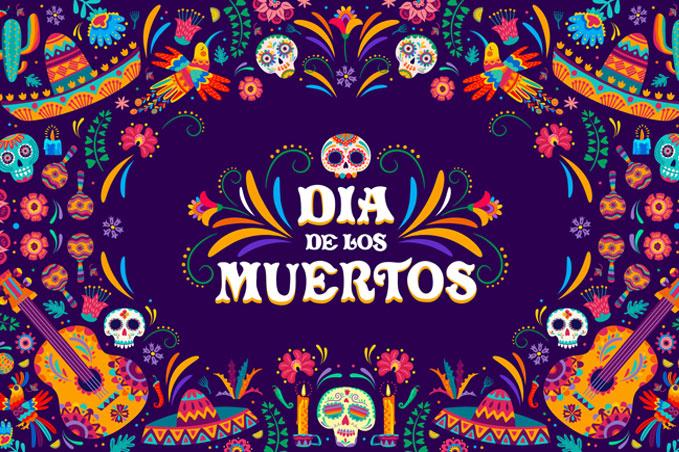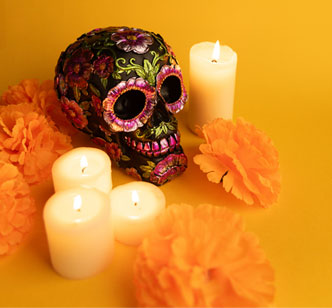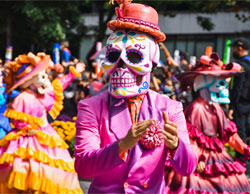
As October fades into November, we don’t just see pumpkins and Halloween witches. We also see marigold blooms, painted skulls, and flickering candles. These colorful decorations are symbols of the celebration of Dia de los Muertos, or Day of the Dead.
Day of the Dead, is a colorful and significant Mexican holiday that celebrates the memory of loved ones who have passed. The holiday is typically celebrated on November 1st and 2nd. Dates that coincide with the Catholic holidays of All Saints’ Day and All Souls’ Day.
Day of the Dead is not a somber occasion but a joyous celebration of life and death. It reflects the belief that the spirits of the departed continue to exist in the afterlife and can reunite with the living during this special time. It is a unique blend of indigenous Aztec traditions and Catholic influences. Together, this blend creates a rich cultural celebration that has gained recognition and popularity beyond Mexico’s borders.
During the Day of the Dead, families come together with their community to honor and remember those who are no longer living. This is achieved through a combination of festive and solemn traditions, including the creation of colorful altars or “ofrendas” adorned with marigold flowers, candles, incense, food, and drink. These ofrendas welcome the spirits of the deceased back to the living world.

common ofrenda elements.
Families also clean and decorate the graves of the deceased, often with marigold petals and sugar skulls. They may spend the night there, sharing stories and memories of the departed. There are parades, musical performances, and artistic displays that feature intricate sugar skulls and decorative skeletons, known as “calacas” and “calaveras.”
Origins of Day of the Dead
The Day of the Dead traces its origins back thousands of years to Mexico’s indigenous cultures. Today’s traditions reflect the festivals that Aztec, Mayan, and Toltec communities created to honor the dead. The native people blended their celebrations with those introduced to them by the Spanish colonizers. That’s why we see the celebrations coincide with the Catholic commemorations of All Saints’ and All Souls’ Days.
It is believed that during the Day of the Dead, spirits reunite with their families and share in the festivities. Beautiful altars are filled with items that are designed to reflect the unique personalities of the departed. These offerings, or “ofrendas,” are considered sacred. Each ofrenda is deeply personal, reflecting the unique bond between the living and the dead. In homes and cemeteries, families gather to share stories, sing, and even laugh, creating an atmosphere of warmth and connection.
Common elements of ofrenda include:
- Marigolds (cempasúchil): The colorful orange petals and powerful fragrance of marigolds. Also known as “flower of the dead,” marigolds actively guide spirits to the ofrenda.
- Candles: Lit to illuminate the path for returning souls.
- Photos and mementos: Personal items that evoke memories of the loved one.
- Food and drink: Favorites of the deceased, such as tamales, pan de muerto (a sweet bread), or even a bottle of tequila or mezcal.
- Sugar skulls (calaveras): Intricately decorated confections inscribed with the names of the departed.
- Papel picado: Intricately designed, colorful tissue paper cutouts to symbolize how fragile life is.
Community Involvement in Day of the Dead

commonly used to commemorate
the Day of the Dead.
While ofrendas offer very personal commemoration, communities often gather to celebrate the holiday together. Parades, music, and vibrant displays dot town squares. In some areas, boat parades, elaborate costumes, and painted faces are common. Face painting, in fact, is an essential hallmark of the holiday. The designs offer a playful embrace of mortality.
In the U.S., festivals, art exhibits, and school activities mark the holiday. Cities with large Mexican communities host large-scale events. Social media is filled with families posting photos of their activities, food trucks serve Day of the Dead-inspired recipes, and artists create works to commemorate the celebrations.
Final Thoughts on Day of the Dead
To those who celebrate it, Day of the Dead is much more than a holiday. Instead, it serves as a profound reminder of how interconnected life is with death. It reminds them that remembrance keeps the spirits of those who came before us alive. It’s a way to keep legacies alive and recognize the beauty of the circle of life.
